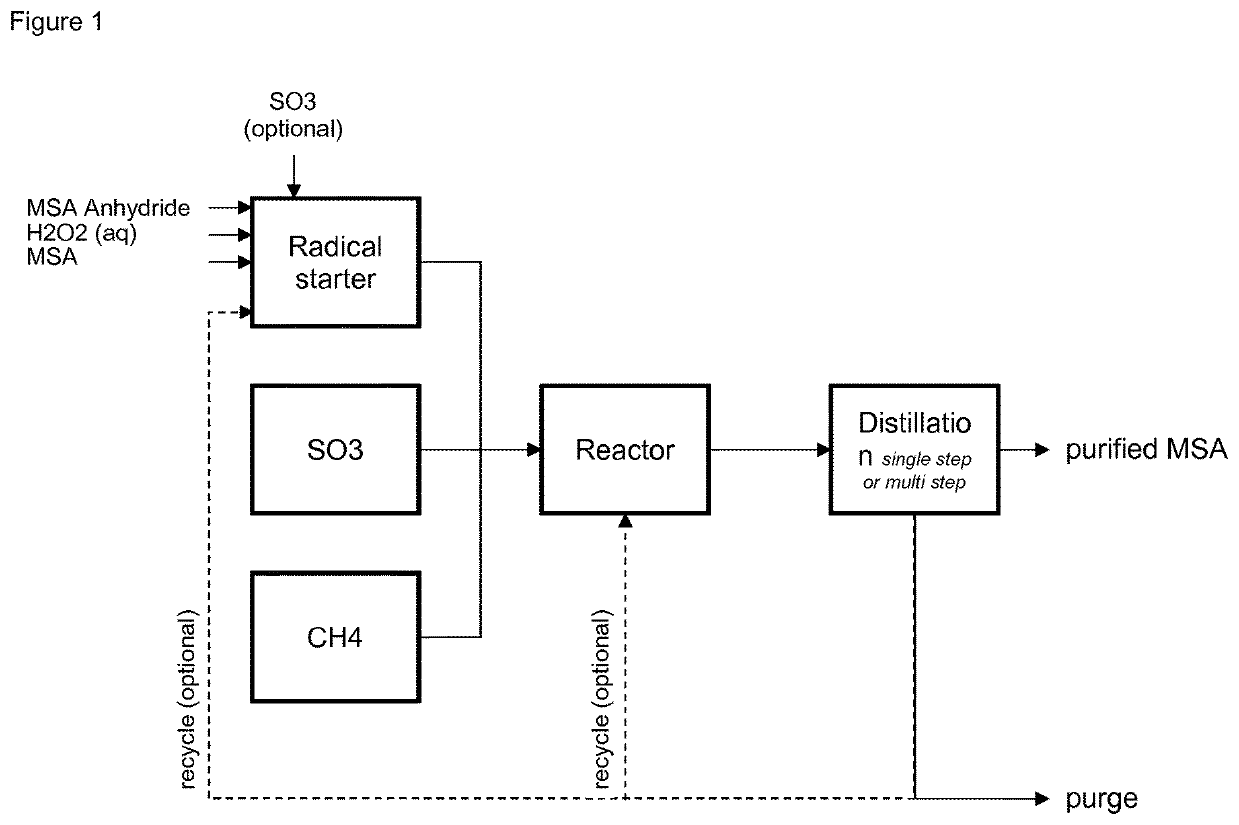Process for the manufacturing of methane sulfonic acid
- Summary
- Abstract
- Description
- Claims
- Application Information
AI Technical Summary
Benefits of technology
Problems solved by technology
Method used
Image
Examples
examples
[0077]1) MSA Anhydride as Water Scavenger[0078]2 g MSA anhydride (purchased from Aldrich, purified by sublimation) was dissolved in 50 g MSA (99.99 wt-%) at room temperature under stirring. Under continuous stirring 1.02 equivalents of water—relative to MSAA—were added to the mixture at room temperature.[0079]Hydrolysis of MSAA to MSA was followed by 1H NMR (Bruker Avance III HD 400 MHz, C6D6 was used in a capillary as the lock reference. The following NMR-shifts were used to identify and quantify the respective compounds:
Substance1H-NMR shift [ppm]MSA (H3C—SO3H)δ(1H, CH3) = 3.43MSA Anhydride (H3C—SO2—O—SO2—CH3)δ(1H, CH3) = 3.7[0080]After ca. 5 h 50% of the MSA anhydride hydrolyzed to MSA and after 5 d 75% of the MSA anhydride hydrolyzed to MSA.[0081]To finalize hydrolyzation the mixture was heated to 50° C., a sample was taken after 3 h and immediately analyzed by 1H NMR. No MSAA could be found in this sample any more.
[0082]2) MSA Anhydride as Water Scavenger in the Presence of Hyd...
example 3 (
Feed to Distillation with 20 wt-% Sulfuric Acid)
[0092]Raw MSA from the reaction of methane and SO3 was purified in a two-column set-up as described in the BASF unpublished patent application no. EP 17173574.9. The raw MSA consisted of 78.8 wt-% MSA, 20.0 wt-% sulfuric acid, 0.2 wt-% MSA anhydride, 0.1 wt-% methane and ca. 160 ppm methylmethanesulfonate. The MSA mass flow was 2000 kg / h. The raw MSA was sent to the distillation after depressurizing the mixture from a pressure in the synthesis unit of ca. 100 bar to 1 bar in a flash unit.
[0093]In a first distillation step (column 1), light boilers are removed from raw MSA at the top of the column (ca. 30 kg / h) and purified MSA is removed via side discharge (TMSA at discharge 163° C.). In the second distillation step (column 2) MSA is depleted of high boilers, especially of sulfuric acid. One fraction of the high boilers is purged from the second column via a discharge line at the bottom (purge: 643 kg / h, 21 wt-% MSA, 79 wt-% sulfuric a...
example 4 (
Feed to Distillation with 18 wt-% Sulfuric Acid)
[0096]The same process simulation and the same distillation conditions (e. g. pressures, temperatures) were used as in example 3. The only difference was that the concentration of sulfuric acid in the feed to the distillation was reduced from 20 wt-% to 18 wt-% assuming that the formation of an incremental amount of sulfuric acid could be suppressed by applying MSA anhydride as water scavenger in the synthesis of the radical starter according to this invention. The reduced amount of sulfuric acid was replaced by additional MSA in the feed stream. The total amount of MSA was kept constant at 2000 kg / h.[0097]The lower sulfuric acid concentration in the feed to the distillation allows to reduce the purge from 643 kg / h to 557 kg / h, at the same time the MSA yield increases from 93.2% to 94.5% and the energy consumption for the evaporation drops from 881 kWh to 775 kWh (evaporation energy only, no condensation energy, no pumping energy).
PUM
| Property | Measurement | Unit |
|---|---|---|
| Temperature | aaaaa | aaaaa |
| Temperature | aaaaa | aaaaa |
| Temperature | aaaaa | aaaaa |
Abstract
Description
Claims
Application Information
 Login to View More
Login to View More - R&D
- Intellectual Property
- Life Sciences
- Materials
- Tech Scout
- Unparalleled Data Quality
- Higher Quality Content
- 60% Fewer Hallucinations
Browse by: Latest US Patents, China's latest patents, Technical Efficacy Thesaurus, Application Domain, Technology Topic, Popular Technical Reports.
© 2025 PatSnap. All rights reserved.Legal|Privacy policy|Modern Slavery Act Transparency Statement|Sitemap|About US| Contact US: help@patsnap.com

